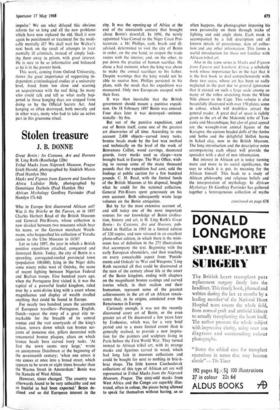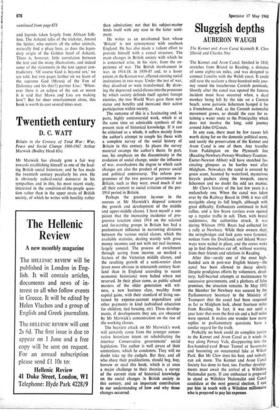Stolen treasure
J. B. DONNE
Great Benin : Its Customs, Art and Horrors H. Ling Roth (Routledge 120s) Tribal Masks from Nciprstek Museum, Prague Erich Herold, photographed by Jindrich Marco (Paul Hamlyn 50s) Masks and Figures from Eastern and Southern Africa Ladislav Holy, photographed by Dominique Darbois (Paul Hamlyn 50s) African Mythology Geoffrey Parrinder (Paul Hamlyn 17s 6d) Who in Europe first discovered African art? Was it the Briicke or the Fauves, or in 1897 Charles Herbert Read of the British Museum and General Pitt-Rivers, whose collection is now divided between two museums which bear his name, or the German merchant Weich- mann, who bequeathed his collection of Yoruba curios to the Ulm Museum in 1638?
Let us take 1897, the year in which a British punitive expedition attacked, conquered and destroyed Benin. Today,,the city of Benin is a sprawling, corrugated-roofed provincial town (population 100,000), lying in the Niger delta some ninety miles west of Onitsba, the scene of recent fighting between Nigerian Federal and Biafran troops. Five hundred years ago, when the Portuguese first visited it, it was the capital of a powerful feudal kingdom, ruled over by a semi-divine king with a court whose magnificence and display of wealth rivalled anything that could be found in Europe.
For nearly two hundred years the accounts of European travellers—Portuguese, English, Dutch—repeat the story of a great city re- markable for the breadth of its central avenue and the vast courtyards of the king's palace, towers down which ran bronze ser- pents of immense size, pillars decorated with ornamental bronze plaques, altars on which bronze heads bore carved ivory tusks. 'At first the town seems very large,' wrote an anonymous Dutchman at the beginning of the seventeenth century; 'when one enters it one comes at once into a broad street, which appears to be seven or eight times broader than the Warme Street in Amsterdam.' Benin was the Xanadu of West Africa.
However, times changed. The country was afterwards found to be very unhealthy and not so fruitful as had been expected' Benin de- clined. and so did European interest in the city. It was the opening-up of Africa at the end of the nineteenth century that brought about Benin's downfall. In 1896, the newly appointed Vice-Consul to the Niger Coast Pro- tectorate, a Mr Phillips, rash, brash and ill- advised, determined to visit the city of Benin in order, on the one hand, to reopen the trade routes with the interior, and, on the other, to put down the practice of human sacrifice. He chose a bad moment, when the king was about to make the annual sacrifices to his father. Despite warnings that the king would not be able to receive him, Phillips persisted in his plans, with the result that his expedition was massacred. Only two Europeans escaped with their lives.
It was then inevitable that the British government should mount a punitive expedi- tion. On 18 February 1897 Benin was entered. Four days later it was destroyed—uninten- tionally--by fire.
But out of the punitive expedition, and out of Benin itself, came one of the greatest art discoveries of all time. According to one account 2,400 objects—carved ivory tusks, bronze heads made by the lost wax method and technically on the level of the work of Benvenuto Cellini, wood carvings, decorated gourds, ivory masks used as clasps—were brought back to Europe. The War Office, wish- ing to recoup some of the many thousand pounds that the expedition had cost, sold the findings at public auction for a few hundred pounds. C. H. Read, with the limited funds of the British Museum at his disposal, bought what he could for the national collection. General Pitt-Rivers spent generously on his own account. Both subsequently wrote large volumes on the Benin antiquities.
But by far the most extensive account of, and still today one of the most important sources for our knowledge of Benin civilisa- tion, history and art, is H. Ling Roth's Great Benin : Its Customs, Art and Horrors, pub- lished in Halifax in 1903 in a limited edition of 320 copies, and now reissued in an excellent photo-offset edition, in which there is the mini- mum loss of definition in the 275 illustrations that accompany the text. Beginning with the early European chroniclers, and then touching on every conceivable aspect from 'Punish- ments and Ordeals' to War and Weapons,' Ling Roth recorded all that could be discovered at the turn of the century about life at the court of the Benin kingdom, ending with chapters on the magnificent bronze castings and carved ivories which, in their realism and their humanism, represent some of the greatest achievements in the art of an African renais- sance that, in its origins, antedated even the Renaissance in Europe.
Curiously enough, it was not the recently discovered court art of Benin, or the even greater art of Ife discovered a few years later by Frobenius, which was, for a very brief period and to a more limited extent than is generally realised, to provide a new inspira- tion for the painters and sculptors living in Paris before the First World War. They turned instead to African tribal art, with its strange masks and figurines carved in wood, which had long lain in museum collections and could be bought for next to nothing in bric-a- brac shops. The little known Czechoslovak collections of this type of African art are well represented in Tribal Masks from the Ndprstek Museum, Prague. The sixty-odd masks from West Africa and the Congo are superbly illus- trated, often in colour, the pieces being allowed to speak for themselves without having, as so
often happens, the photographer imposing his own personality on them through tricks of lighting and odd angle shots. Each mask is accompanied by a full description and all known details of provenance, date of collec- tion and any other information. This forms a useful introduction for those not familiar with African tribal art.
Also in the same series is Masks and Figures from Eastern and Southern Africa, a scholarly work whose importance lies in the fact that it is the first book to deal comprehensively with these two areas, whose art has been so sadly neglected in the past due to general ignorance that it existed on such a large scale among so many- of the tribes stretching from the White Nile almost to the Cape. This volume is also beautifully illustrated with over 150 plates, some in colour, which will doubtless attract the general reader. A great deal of space is rightly given to the art of the Makonde tribe of Tan- zania and Mozambique, but also of great appeal are the wrought-iron animal figures of the Karagwe, the curious beaded dolls of the Ambo and Sotho and the delightful Shilluk hyena in baked clay, now in the British Museum. The long introduction and the descriptive notes accompanying each object will provide the specialist with a deal of new information.
But interest in African art is today turning more and more to its social significance, the uses to which it is put, its meaning for the African himself. This leads to a study of African philosophy and religious beliefs and the interpretation of mythology. In African Mythology Dr Geoffrey Parrinder has gathered together a heterogeneous collection of myths
continued on page 676
continued from page 673 and legends taken largely from African folk- lore. The Ashanti tales of the trickster, Anansi the Spider, who outwits all the other animals, naturally find a place here, as does the legen- dary origin of the Golden Stool of Ashanti. There is, however, little correlation between the text and the many illustrations, and indeed some of the statements in the text appear con- tradictory. 'Of course God is beyond sex,' we are told, but two pages farther on we learn of the supreme God (Mawu) of the Fon of Dahomey and his (her?) partner Lisa : `When- ever there is an eclipse of the sun or moon it is said that Mawu and Lisa are making love'! But for sheer entertainment alone, this book is worth its cost several times over.







































 Previous page
Previous page